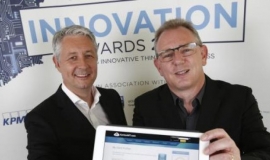
DCU Spin-out KantanMT is finalist in ‘The Irish Times’ Innovation Awards 2016
07 July 2016
Founded by serial entrepreneur Tony O’Dowd, KantanMT is a cloud-based custom machine translation solution.
KantanMT is a platform that delivers large-scale automated translation. It uses the computing power, scalability and economics provided by cloud computing to deliver higher-quality, machine-generated translations of a vast range of materials. Its customers have been able to translate billions of words of content that would have taken too long and been too expensive to translate using traditional methods.
The solution came about as a result of O’Dowd’s long association with the translation and localisation sector as well as a chance decision to go back to college. Having worked in the software localisation industry and then for tech sector giants Lotus, Symantec and Corel, he went on to found his own software development firm, Alchemy, in 2000.
“I sold Alchemy and part of the sale was a three year earn-out deal where I was engaged in transferring the technology and knowledge within the company to California, ” he says. “I had effectively completed this project within two years and that gave me time to start thinking about new challenges and I decided to go back to college to do a PhD in DCU.”
His chosen subject was machine translation. “I had always had an interest in machine translation and why more people weren’t using it. It came down to the three Cs: cost, complexity and challenges. When I finished the earn-out I went to DCU and started working with the Centre for Next Generation Localisation [CNGL; now Adapt] out there and got the opportunity to talk to other PhD students about machine translations. I asked them if there was a way to solve the three Cs and we built a prototype website which became Kantan.”
Visual tools
The online service was cheap and easy to use and came with visual tools to help users manage complexities. Within 60 days of going live in October 2014, the trial version had 400 clients.
“We saw that it was resonating with customers so we spent the next six months refining the solution and successfully raised venture capital funding. We have grown to employ 18 people, we have 700 servers, and we translated 6½ billion words in 2015,” O’Dowd says.
“Lionbridge, one of the biggest firms in the localisation sector, just celebrated translating one billion words in a year for the first time.”
The company is now “hugely profitable”, he says.
“We have grown by 800 per cent in the past year, we will translate 18 billion words this year and this will double to 36 billion next year. We charge our customers a small fraction of a cent per word translated and this makes it very affordable and cost-effective for them and profitable for us because of our scale.”
Machine translation has been around for a long time but hasn’t managed to make the breakthrough KantanMT has. So what is so special about this solution?
The answer lies in the different approach taken by O’Dowd and his team. Traditional machine translation systems are rules-based. They work on logical “if then” propositions: if one word in one language is followed by another, then the translation must be one thing in another language. That worked to a certain extent but was prone to errors due to context issues and required large amounts of time-consuming, costly human post-editing.
Business model
The KantanMT solution has moved away from this method and instead uses the power of big data to match the content to be translated with previously translated work which is already online. This improves accuracy, speeds up the process and reduces the requirement for human post-editing.
The other great advantage is the business model employed by KantanMT.
“It is a cloud-based solution accessed through the web,” says O’Dowd. “In the past a single translation engine for a specific topic and pair of languages would have cost hundreds of thousands of euro to develop. That’s because the other firms in the space operate on a consultancy professional services contract basis.
“With KantanMT there is no capital expenditure involved, no upfront consultancy fees, but just a small subscription fee and a very small charge per word translated.”
This software-as-a-service model is certainly proving attractive across many other sectors and the KantanMT numbers speak for themselves.
O’Dowd believes the dramatic cost reductions and quality improvements offered by KantanMT will actually grow the market both for machine and human translation.
“There is a huge amount of content which doesn’t get translated now because of cost and complexity,” O’Dowd says. “This is a barrier to trade as well as everything else. We are solving this problem and making it cost-effective to translate this content.
“Machine translation will always require some post-editing if only as a final accuracy check and this will create work for translators.”

